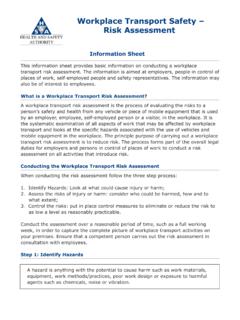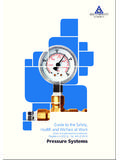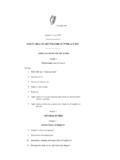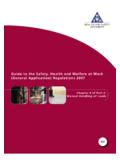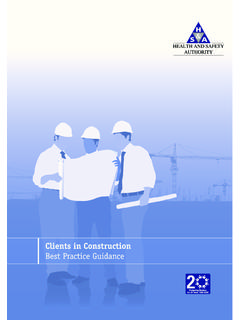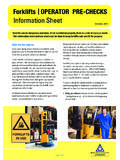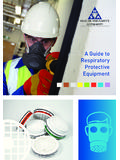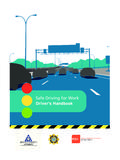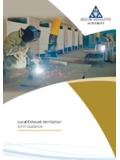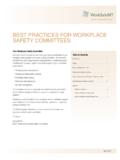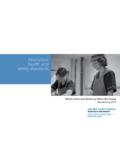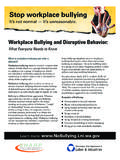Transcription of Workplace Safety and Health Management
1 Policy Audit and review Planning Measuring Implementation performance and operation Workplace Safety and Health Management 14. Workplace Safety . AND Health . Management . Practical Guidelines on the Implementation and Maintenance of an Occupational Safety , Health and Welfare Management System Published by the Health and Safety Authority Published in January 2006 by the Health and Safety Authority, 10 Hogan Place, Dublin 2. All rights reserved. No part of this publication may be reproduced, stored in a retrieval system, or transmitted in any form or by any means, electronic, mechanical, photocopying, recording or otherwise, without the prior permission of the Health and Safety Authority.
2 Page Introduction .. 7. 1. Key elements of a Safety and Health Management System Policy and Commitment .. 8. Planning .. 8. Implementation and Operation .. 8. Measuring Performance .. 9. Auditing and Reviewing Performance .. 9. 2. Initial Safety and Health Management System 11. 3. Safety and Health Management System Model .. 13. Safety and Health 13. Developing a Workplace Safety and Health Policy .. 14. Planning .. 15. Safety and Health Objectives and Targets .. 16. Performance Standards .. 16. Implementation and 17. Structure and Responsibilities .. 17. Management Responsibilities.
3 17. Individual Responsibilities .. 18. Safety Consultation, Participation and Representation .. 19. Training, Awareness and Competence .. 21. 21. Information Coming into the Organisation .. 21. Information Flow within the Organisation .. 21. Information Flow from the Organisation .. 23. Document 23. Safety and Health Management System Records .. 24. Operational Control .. 24. Workplace Precautions .. 24. Hazard Identification .. 25. Risk Assessment .. 26. Risk Control .. 26. Controlling Health Risks .. 27. Management and Control of Contractors .. 28. Procurement, Emergency Preparedness and 29.
4 Measuring Performance .. 30. Monitoring and Measurement .. 30. Active Monitoring .. 31. Reactive 32. Auditing and Reviewing Performance .. 32. Safety and Health Management Systems Audits .. 33. Audit Protocols .. 33. Audit Records .. 33. Reviewing 33. Action for Improvement .. 35. APPENDICES. Appendix A 36. Appendix B Safety and Health Training and 37. Training for Safety and 37. Identify Training Needs .. 37. Organisational Needs .. 38. Job-related Needs .. 38. Individual Needs .. 39. Identify Training Objectives and Methods .. 39. Deliver Training .. 39.
5 Evaluation and Feedback .. 39. Specialist Advice and Services .. 39. Access to Specialist Advice and Services .. 39. Role and Functions of Safety and Health Advisers .. 40. Relationships Within the Organisation .. 40. Relationships Outside the Organisation .. 41. External Specialist Safety and Health 41. Appendix C Risk Assessment and 42. The Legal Basis for Risk Assessment .. 42. Key Stages of Risk Assessment and Control .. 42. Use Trained Risk Assessors .. 42. Prepare an 42. Identify the Hazards .. 43. Assess the Risks .. 43. Identify Appropriate 44. Risk Assessment Records and Control.
6 44. A Simple Risk Estimation 45. Hazards .. 45. Remedial Measures .. 45. Key stages of Risk Asssessment and 46. Appendix D Measuring Safety and Health Performance .. 47. Active and Reactive Monitoring .. 47. Measurement Techniques .. 47. Inspection .. 47. Accident, Ill- Health and Incident 48. Key Data to be Covered in Accident, Ill- Health and Incident Reports 49. The Event .. 49. The Potential Consequences .. 49. Recommendations .. 49. Learning from and Communicating Results from Investigations 49. Cautions in Using Accident and Ill- Health 50. Appendix E Auditing systems.
7 51. Safety and Health Management System Auditing .. 51. Board and Senior Management Commitment to 51. Co-operation with the Auditors .. 51. Essential Elements of a Safety and Health Management .. 51. System Audit .. 52. Planning and Managing Safety and Health Management System audit .. 52. Audit Programme .. 52. Auditor Selection, Competence and Training .. 52. Data Collection and Interpretation .. 52. Audit 52. Acting on Audit Results .. 53. Safety and Health Audit Systems .. 53. Effective Safety and Health Audit Systems .. 53. Safety and Health Policy.
8 53. 53. Planning and Implementation .. 53. Measuring 53. Reviewing System .. 53. 54. International .. 54. Health and Safety Authority 54. Workplace Safety AND Health Management 5. ABOUT THESE GUIDELINES. WHO SHOULD READ THESE GUIDELINES? The guidance is principally aimed at enterprises with a well-defined Management structure, where occupational Safety and Health Management can be integrated into the general Management system. In particular, it is aimed at executive directors, boards of directors, other boards of Management and senior Management controlling bodies in workplaces, all senior managers who discharge responsibilities for occupational Safety and Health , and Safety and Health professionals.
9 Smaller companies with a less formal Management structure can use this guidance as appropriate to their needs. Safety Representatives should also find it helpful. WHY IS IT IMPORTANT TO HAVE AN EFFECTIVE Safety AND. Health Management SYSTEM? There are sound economic reasons for reducing work-related accidents and ill- Health , as well as ethical and regulatory reasons. Economic Reasons Besides reducing costs, effective Safety and Health Management promotes business efficiency. Thousands of work-related accidents, resulting in more than three days off work are reported to the Health and Safety Authority each year.
10 Work-related diseases and ill- Health are more difficult to measure due to their long latency period but result in excess of one million days lost at work each year. These accident and ill- Health cases are due to failures and deficiencies in the occupational Safety and Health Management in organisations. Legal Reasons The Safety , Health and Welfare at Work Act 2005 (the 2005 Act) requires you to ensure, so far as is reasonably practicable, the Safety , Health and welfare of your employees and to manage and conduct your work activities in such a way as to ensure their Safety , Health and welfare.

